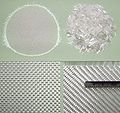science, grain-boundary strengthening (or Hall–Petch strengthening) is a method of strengthening materials by changing their average crystallite (grain) size...
33 KB (4,204 words) - 09:28, 22 August 2024
materials include Work hardening Solid solution strengthening Precipitation strengthening Grain boundary strengthening Where deforming the material will introduce...
22 KB (2,758 words) - 16:22, 4 October 2024
7732 (2018): 546-550. Grain boundary strengthening in alumina by rare earth impurities Mechanism of grain boundary strengthening of steels An open source...
49 KB (6,877 words) - 04:21, 2 May 2024
strengthening effect comes from grain refinement (Grain boundary strengthening), in which strength increases as the grain size decreases. The other mechanisms...
15 KB (1,422 words) - 08:17, 2 November 2024
grain boundary strengthening. B and Zr tend to segregate to the grain boundaries which reduces the grain boundary energy and results in better grain boundary...
82 KB (10,193 words) - 03:22, 18 October 2024
or grain boundary strengthening, is to obtain small grains. Smaller grains increases the likelihood of dislocations running into grain boundaries after...
6 KB (859 words) - 15:50, 4 July 2024
precipitation hardening, and grain boundary strengthening and can be quantitatively and qualitatively explained. Strengthening mechanisms are accompanied...
25 KB (3,680 words) - 10:12, 28 October 2024
There are five hardening processes: Hall-Petch strengthening, work hardening, solid solution strengthening, precipitation hardening, and martensitic transformation...
21 KB (2,479 words) - 01:47, 1 November 2024
Grain boundary sliding (GBS) is a material deformation mechanism where grains slide against each other. This occurs in polycrystalline material under...
22 KB (2,860 words) - 09:11, 9 February 2024
yield strength of nanocrystalline metals is due to grain boundary strengthening, as grain boundaries are extremely effective at blocking the motion of...
13 KB (1,659 words) - 00:12, 10 June 2024
proposed for grain boundary sliding and hence material softening, but the details are still not understood. Besides grain boundary strengthening, much attention...
54 KB (6,863 words) - 12:15, 18 July 2024
boundary and enhances the grain boundary strengthening. However, as the grain gets smaller, the interaction between grain and the dislocation inside...
18 KB (2,220 words) - 05:09, 18 June 2024
be modeled based on effects from grain boundary strengthening, dislocation strengthening, and Orowan strengthening. The most common particle reinforced...
5 KB (700 words) - 13:49, 27 September 2023
Precipitation hardening (redirect from Precipitation strengthening)
the size effect in solid solution strengthening. What differentiates this mechanism from solid solution strengthening is the fact that the precipitate...
36 KB (5,467 words) - 12:54, 4 October 2024
thermal coatings and superalloys with solid-solution strengthening and grain boundary strengthening are used in blade designs. Protective coatings are used...
67 KB (9,439 words) - 16:47, 13 November 2024
Intergranular corrosion (redirect from Grain boundary depletion)
otherwise corrosion-resistant alloys, when the grain boundaries are depleted, known as grain boundary depletion, of the corrosion-inhibiting elements...
10 KB (1,369 words) - 14:41, 21 May 2024
In metallurgy, solid solution strengthening is a type of alloying that can be used to improve the strength of a pure metal. The technique works by adding...
19 KB (2,487 words) - 10:10, 19 May 2024
used as a strengthening phase in high temperature applications. Carbides are also used in polycrystalline superalloys to inhibit grain boundary sliding...
65 KB (8,845 words) - 19:51, 9 October 2024
microscopic localized regions around grain boundaries that are free of precipitates (solid impurities forced outwards from the grain during crystallization). It...
9 KB (955 words) - 15:39, 16 May 2024
The variety of strengthening mechanisms that alter the strength of a material include the mechanism of grain boundary strengthening. Thus, although yield...
59 KB (7,565 words) - 15:30, 18 November 2024
Subgrain rotation recrystallization (redirect from Continuous sub-grain rotation type dynamic recrystallization)
sub-grain boundaries until the mismatch between the crystal lattices across the boundary is sufficient for them to be regarded as grain boundaries. This...
7 KB (800 words) - 01:41, 24 June 2023
superalloys strengthened by metal carbides, increasingly large carbide particles form preferentially at grain boundaries, preventing grain boundary sliding...
15 KB (1,901 words) - 11:56, 2 August 2022
of grain size. This leads to the decrease of grain boundary strengthening effect. Surface grains have lesser constraints compared to internal grains. The...
20 KB (2,106 words) - 13:16, 14 July 2024
meta-crystals. They obey the metallurgical hardening principles (grain boundary strengthening, precipitate hardening etc.) when undergoing deformation. It...
20 KB (2,458 words) - 19:30, 14 November 2024
and grain growth, which can prevent superplastic flow due to grain boundary sliding, in addition to reducing the activation energy for grain boundary sliding...
7 KB (847 words) - 20:56, 7 November 2024
Inconel (section Strengthening mechanisms)
coherency strengthening, making for a weaker material. That being said, in appropriate quantities, the δ phase is responsible for grain boundary pinning...
41 KB (3,808 words) - 21:02, 21 August 2024
chromium carbide results in reduced corrosion resistance along the grain boundary leaving the stainless steel susceptible to unanticipated corrosion in...
12 KB (1,238 words) - 15:20, 11 September 2024
"weaker" grain will yield prior to the "stronger" grain, and as it deforms a stress concentration will build up in the stronger grain near the boundary between...
11 KB (1,603 words) - 14:57, 26 January 2023
feature that develops. Generally, these structures are formed in fine grained rocks composed of minerals affected by pressure solution. Cleavage is a...
11 KB (1,184 words) - 17:11, 4 June 2023
with other elements to increase grain boundary cohesion. Alloying of other materials such as boron to improve grain boundary cohesion can improve ductility...
11 KB (1,109 words) - 14:43, 21 November 2024


















